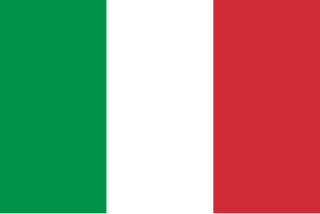
San Marino, officially the Republic of San Marino, also known as the Most Serene Republic of San Marino, is an enclaved microstate surrounded by Italy, situated on the Italian Peninsula on the northeastern side of the Apennine Mountains. Its size is just over 61 km2 (24 sq mi), with a population of 33,562. Its capital is the City of San Marino and its largest settlement is Dogana in the municipality of Serravalle. San Marino has the smallest population of all the members of the Council of Europe. With Italian being the official language, along with strong financial and ethno-cultural connections, San Marino maintains close ties to its much larger neighbour; it is located close to the riviera of Rimini, one of Italy's main coastal resort areas.
As the only surviving medieval microstate in the Italian peninsula, the history of San Marino is intertwined with medieval, renaissance and modern-day history of the Italian peninsula, beginning with independence from the Roman Empire on 257 AD.
The demographics of San Marino, include population density, ethnicity, education level, economic status, religious affiliations and other aspects of the population.

Year 992 (CMXCII) was a leap year starting on Friday of the Julian calendar.

The County of Urgell is one of the historical Catalan counties, bordering on the counties of Pallars and Cerdanya.

Saint Marinus was the founder of a chapel and monastery, in 301. From this initial community the state of San Marino later grew.

Jordan was the first Bishop of Poland from 968 with his seat, most probably, in Poznań. He was an Italian or German.

Oswald of Worcester was Archbishop of York from 972 to his death in 992. He was of Danish ancestry, but brought up by his uncle, Oda, who sent him to France to the abbey of Fleury to become a monk. After a number of years at Fleury, Oswald returned to England at the request of his uncle, who died before Oswald returned. With his uncle's death, Oswald needed a patron and turned to another kinsman, Oskytel, who had recently become Archbishop of York. His activity for Oskytel attracted the notice of Archbishop Dunstan who had Oswald consecrated as Bishop of Worcester in 961. In 972, Oswald was promoted to the see of York, although he continued to hold Worcester also.

The Catholic Church in Italy is part of the worldwide Catholic Church in communion with the Pope in Rome, under the Conference of Italian Bishops. The pope serves also as Primate of Italy. In addition to Italy, two other sovereign nations are included in Italian-based dioceses: San Marino and the Vatican City. There are 225 dioceses in the Catholic Church in Italy, see further in this article and in the article List of Catholic dioceses in Italy.

The Roman Diocese Catholic of Brescia is a Latin rite suffragan diocese in the ecclesiastical province of the Metropolitan Archdiocese of Milan, in Lombardy.

Ippolito (I) d'Este was an Italian Roman Catholic cardinal, and Archbishop of Esztergom. He was a member of the ducal House of Este of Ferrara, and was usually referred to as the Cardinal of Ferrara. Though a bishop of five separate dioceses, he was never consecrated a bishop. He spent much of his time supporting the ducal house of Ferrara and negotiating on their behalf with the Pope.

Eugene Antonio Marino was an American Catholic prelate who served as Archbishop of Atlanta, Georgia from 1988 until 1990, becoming the first African American archbishop in United States of America. He was of both African American and Puerto Rican descent.

Marino Grimani (c.1489–1546) was an Italian Cardinal and papal legate. He was from an aristocratic Venetian family.

The Italian Catholic Diocese of San Marino-Montefeltro was until 1977 the historic Diocese of Montefeltro. It is a Latin suffragan of the Archdiocese of Ravenna-Cervia. The current diocese includes all the parishes of San Marino.

The Italian Catholic Diocese of Treviso is in the Veneto. It is a suffragan of the Archdiocese of Venice.
San Marino is a small landlocked country with an area of about 61.2 km2 (23.6 sq mi) on a rocky promontory at an elevation of 657 meters (2,156 ft) in central Italy. It is the third smallest country after Vatican and Monaco. It was founded as a Republic in 600 AD and recognized by the Papacy in 1631, and became a member of the United Nations in 1992. As of 2009, it had a population of 31,500. The ethnic composition is about 84.95% Sammarinese, 14.6% Italians and others. The country does not provide exact statistics of the religious affiliations of its people. However, it is inferred that at least 95% of the people are Catholics, as in Italy, but with a historical Jewish and Protestant minority. There are other small groups, including Jehovah's Witnesses, Bahá'ís, Muslims, and Waldensians. San Marino's schools are all public and financial support is provided by the State; there are no private religious schools.
Marino Acciabianca was a Roman Catholic prelate who served as Bishop of Nusco (1514–1523).
Marino Giovanni Zorzi or Marino Giovanni Giorgi was a Roman Catholic prelate who served as Bishop of Brescia (1644–1678).

Francesco Marino is an Italian ordinary of the Catholic Church and the current Bishop of Avellino.
Events during the year 2019 in Italy.

















